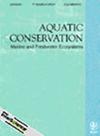Behaviours of Sea Turtles in Shipwrecks in Northeast Brazil
IF 2.5
3区 环境科学与生态学
Q3 ENVIRONMENTAL SCIENCES
引用次数: 0
Abstract
- Shipwrecks are one of the most common types of artificial reefs. They are home to several sea creatures, including sea turtles. Here, we aim to understand the relationship between sea turtles and shipwrecks by investigating species occurrence, behaviours and food availability in artificial reefs in Pernambuco, Northeast Brazil.
- To map sea turtle occurrence in shipwrecks, we considered data from the literature, and we inspected 54,145 photos resulting from 867 recreational dives performed in 19 shipwrecks. We then selected four wrecks for systematic behavioural observations through 97 h and 56 min of passive video recordings. We also investigated potential food resources for turtles in these shipwrecks.
- We identified three turtle species (i.e., Chelonia mydas, Eretmochelys imbricata and Caretta caretta), but most records were juvenile Chelonia mydas individuals using conserved wrecks. We recorded nine behaviours. ‘Resting’ was the predominant activity for all three species, representing over 60% of the records for all species. Their overall activity pattern varied. The wrecks were predominantly encrusted with ascidia, octocoral, sponge and algae—organisms that are part of sea turtles' diet. We highlight the ecological role of the shipwrecks for sea turtles since they may serve as shelter (especially for the juveniles of Chelonia mydas), potentially protecting them against predators and strong currents. The wrecks may also serve as potential feeding areas for sea turtles. We reinforce the need to establish appropriate regulations for recreational dive tourism in shipwrecks in Brazil to avoid disturbing sea turtles in this ecologically important artificial reef.
巴西东北部沉船中的海龟行为
沉船是最常见的人工珊瑚礁类型之一。它们是包括海龟在内的多种海洋生物的家园。在这里,我们旨在通过调查巴西东北部伯南布哥州人工鱼礁中的物种出现、行为和食物供应情况,了解海龟与沉船之间的关系。 为了绘制海龟在沉船中出现的地图,我们参考了文献中的数据,并检查了在 19 艘沉船中进行的 867 次休闲潜水所拍摄的 54145 张照片。然后,我们选择了四艘沉船,通过 97 小时 56 分钟的被动视频记录,进行了系统的行为观察。我们还调查了这些沉船中海龟的潜在食物资源。 我们确定了三个海龟物种(即Chelonia mydas、Eretmochelys imbricata和Caretta caretta),但大多数记录都是使用受保护沉船的幼年Chelonia mydas个体。我们记录了九种行为。休息 "是所有三个物种的主要活动,占所有物种记录的 60% 以上。它们的总体活动模式各不相同。沉船上主要覆盖着海鞘、章鱼、海绵和藻类--这些都是海龟的食物。我们强调了沉船对海龟的生态作用,因为沉船可能是海龟的庇护所(尤其是对海龟幼体而言),有可能保护它们免受捕食者和强水流的伤害。沉船还可能成为海龟的潜在觅食区。我们强调有必要为巴西沉船的休闲潜水旅游制定适当的法规,以避免在这一具有重要生态意义的人工礁石上对海龟造成干扰。
本文章由计算机程序翻译,如有差异,请以英文原文为准。
求助全文
约1分钟内获得全文
求助全文
来源期刊

Aquatic Conservation-Marine and Freshwater Ecosystems
环境科学-海洋与淡水生物学
CiteScore
5.50
自引率
4.20%
发文量
143
审稿时长
18-36 weeks
期刊介绍:
Aquatic Conservation: Marine and Freshwater Ecosystems is an international journal dedicated to publishing original papers that relate specifically to freshwater, brackish or marine habitats and encouraging work that spans these ecosystems. This journal provides a forum in which all aspects of the conservation of aquatic biological resources can be presented and discussed, enabling greater cooperation and efficiency in solving problems in aquatic resource conservation.
 求助内容:
求助内容: 应助结果提醒方式:
应助结果提醒方式:


